Family : Hylidae

Text © Dr. Edoardo Di Russo

English translation by Mario Beltramini
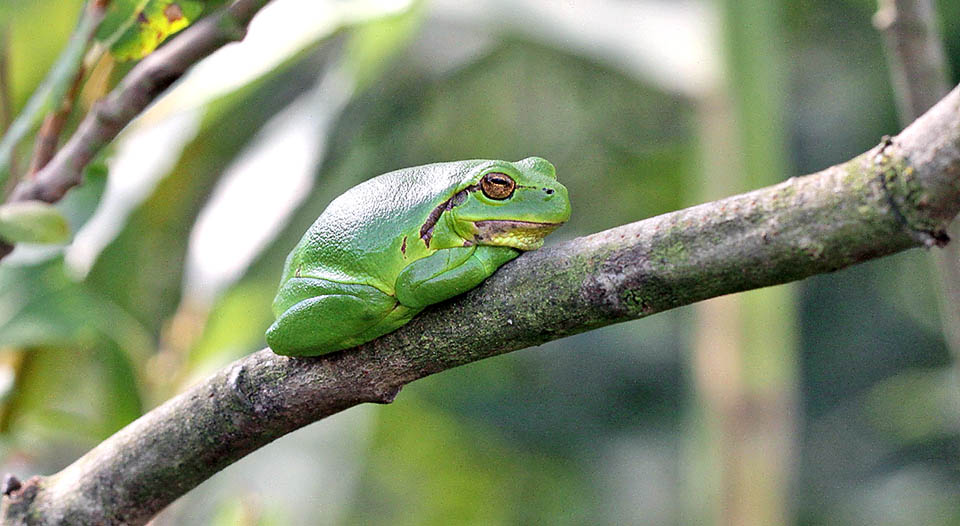
3-4 cm long, with females sometimes 6, the Common tree frog (Hyla arborea) is a palearctic species present in most Europe and west Asia © Ge van ‘t Hoff
The Common tree frog or European tree frog Hyla arborea (Linnaeus, 1758), belongs to the class of the Amphibia, the vertebrates that spend at least a part of their life cycle in the aquatic world, to the order of the Anura, the tailless amphibians, and to the large family of the Hylidae, the small tree frogs characterized by phalanges that allow to adhere to the substratum like a sucker.
The species is inserted in the Annex II of Bern Convention dated 1979 for the conservation of the wild life and of the biotopes in Europe and in the Annex 4 of the Habitats Directive of 1992 for the conservation of the natural and semi natural habitats and of the flora and of the wild fauna. The IUCN (International Union for Conservation of Nature) in its 2006 Red List reports this species with the status of (LC, Least Concern).
The name of the genus Hyla may be brought back to the Greek verb “ὑλάω” (hyláo), that means to howl, to remind the hoarse sound characteristic of these species; conversely, the specific epithet arborea comes from the Latin arboreus, adjective meaning “of the trees”, that refers to the arboricolous ecology of the species.
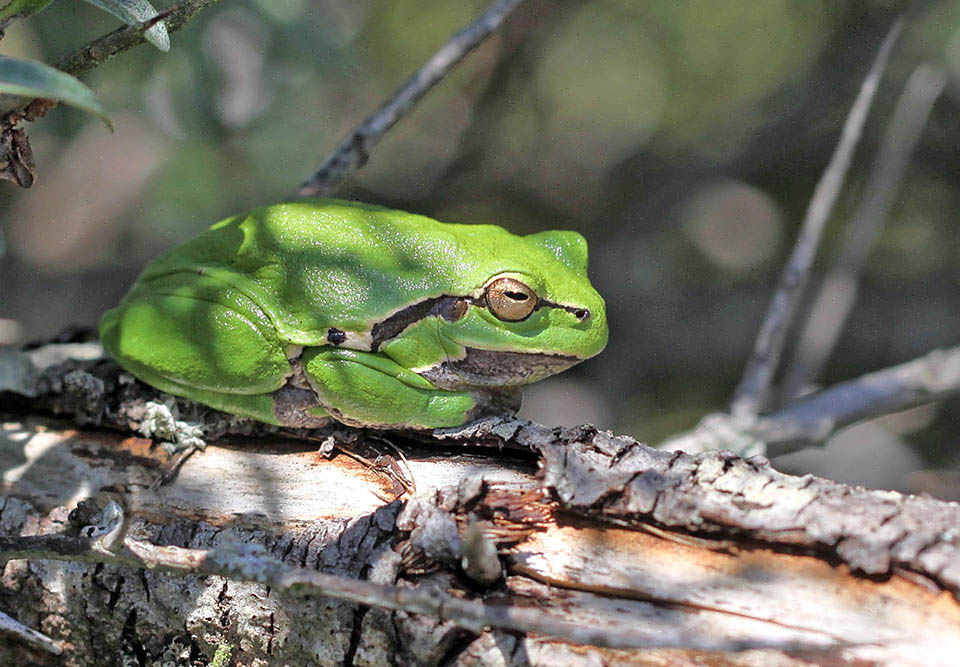
In the day it sleeps hidden on trees and shrubs where it climbs thanks to the apical discs of the limbs and is mainly active the night © Ge van ‘t Hoff
Zoogeography
Species with Palearctic distribution, is present throughout much of Europe and of western Asia. In Europe its limits are to north with Denmark and South Sweden, to south with the Balkans, from west to east it is present from Portugal up to the Asian Turkey and the southern Russia of the Caspian Sea.
In Italy it’s present only in two areas of Friuli Venezia Giulia. The altitudinal record for the Common tree frog has been reported at about 2300 m in Bulgaria, on the Rila mountains.
Presently are not yet recognized valid its subspecies as between the different populations there are cases of genetic introgression.
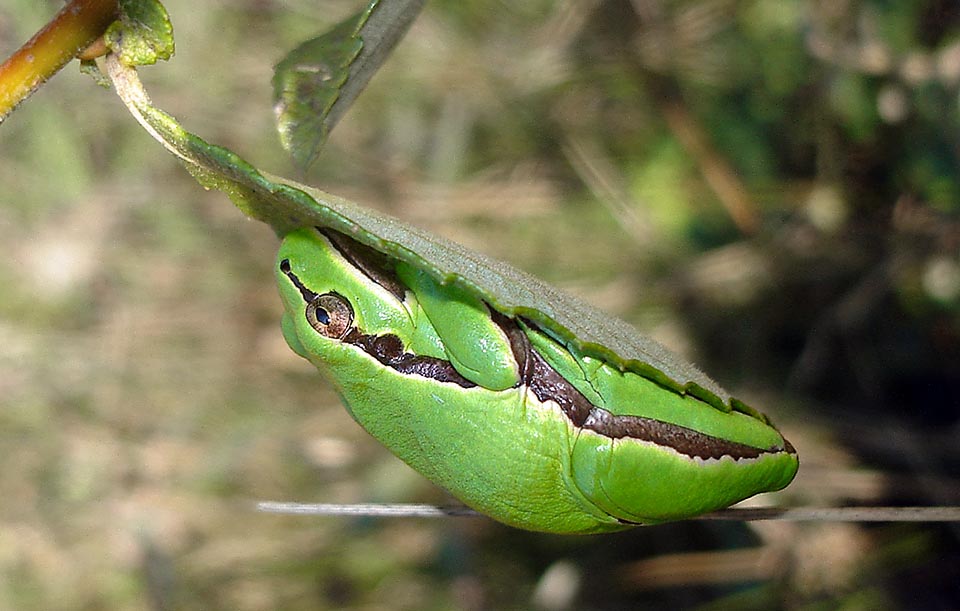
Here, to avoid being noted by the flying predatory birds, it has even stuck with the granular belly under a leaf © Rafael Vazquez Graña
Ecology-Habitat
It frequents mainly static aquatic environments such as ponds and pools but may be observed also in anthropic environments like swimming pools or cisterns. Despite its preference for the humid zones during its movements, it may get away even several hundred metres from the water. It’s a very mobile species so much that it may cover even 4 km in a few days.
During its adult life it spends most of the time on the shrubs and among the branches of the trees.
During the mating period the individuals stop on the vegetation located on the banks of water bodies like broad-leaved herbs, reeds, bushes and cattails. The newly metamorphosed juveniles continue to frequent these environments of banks and, growing, move to more arboreal sites.
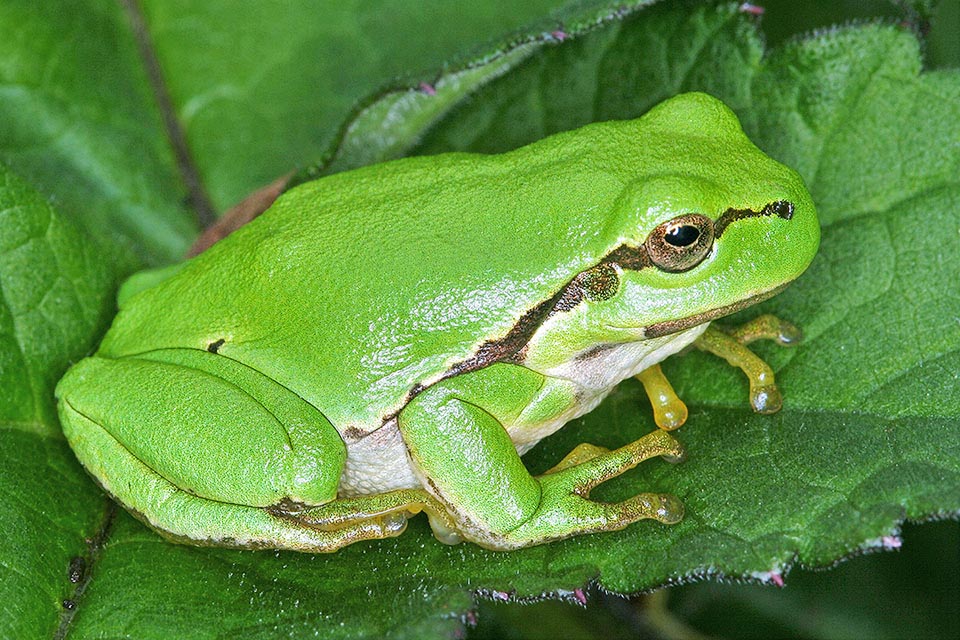
Not lazy at all, hunts by night also flying insects and jumping from one branch to another, can move in few days, if necessary, even of 4 km © Christian Hugues
It is an eurythermal species that adapts well to a variety of temperatures.
The Common tree frog spends its hibernation and aestivation periods in its sheltered underground, or under rocks, under rotting trunks, under moss or inside grottoes.
Morphophysiology
The Common tree frog like the other congeneric species is characterized by a bright green colouration, even if some individuals, depending on the physiological conditions may display darker colours going from dark green to grey.
The belly is always paler than the back with colours varying from white to grey. Rarely the throat has green intrusions from the back.
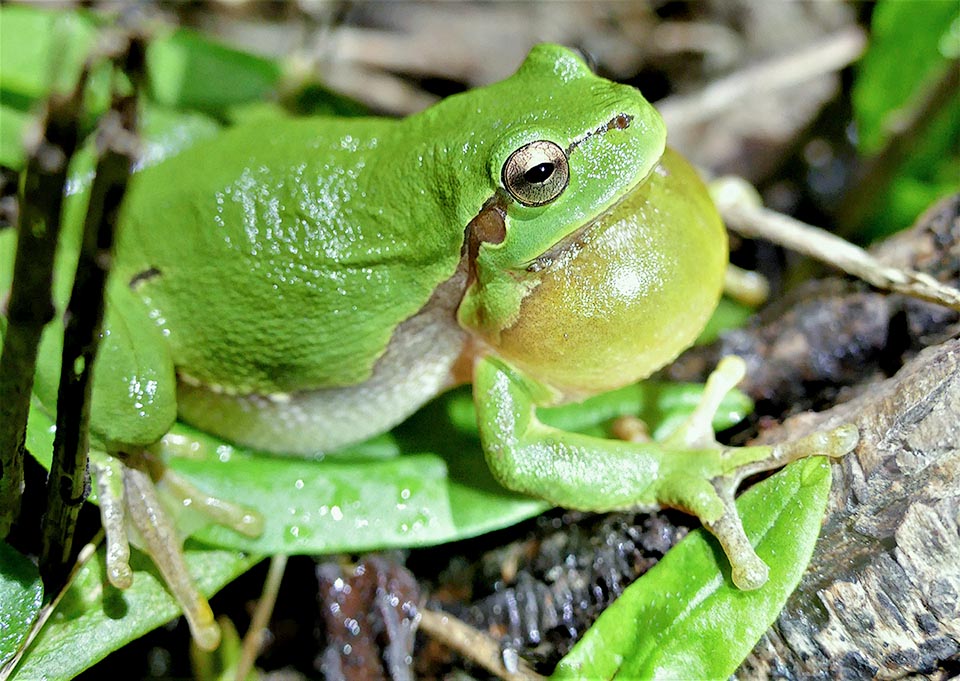
Seeks static aquatic environments, like ponds and pools, and to limit the territory and attract females dozens of males sing loud night choruses © Paul Bachhausen
The testicles are poorly coloured, whitish or yellowish. In nature have also been observed individuals presenting a light blue mutation in the back colouration.
It presents two dark longitudinal bands, margined above in more or less strong white, that start from the nostrils, through the eyes, the eardrums, and end in the inguinal region where they return up for a small portion on the back.
The head has a short snout, rounded and little protruding. The iris of the Common tree frog is of a lively golden colour, but may show some brown vermiculatures at times scattered to fill the entire eye. The pupil is horizontal. The eardrum is small but well visible.
On the back its skin is very smooth, instead on the ventral side and on the inner side of the thighs it is more granular.
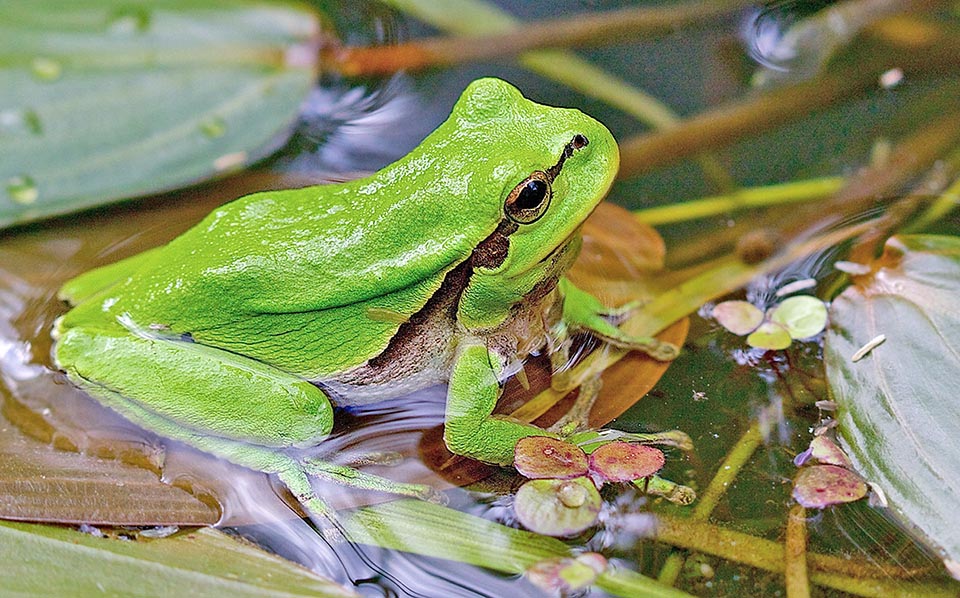
Reproductive season that at times occurs in alternate years, begins in February-March in the warmest zones and ends in July in the coldest ones © Gediminas Gražulevičius
The forelimbs have 4 toes with a just noticeable webbing and subdigital apical discs, whilst the toes of the hind limbs have 5 webbed toes starting from the 2/3 of their length. The average length of the individuals of the Common frog tree stands between 3 and 4 cm. The sexual dimorphism is evidenced by the throat vocal sac: in the males this is almost always visible with a yellowish, brown-reddish colour.
When in heat in the males the first toe of the hand is covered with small horny granules to form a wide excrescence. The females, moreover, have a larger build and can reach the length of 6 cm. Unlike males, the females under their throat have a much rougher and granular skin.
Ethology-Reproductive Biology
The Common tree frog is a climbing species, like all species of the genus Hyla.
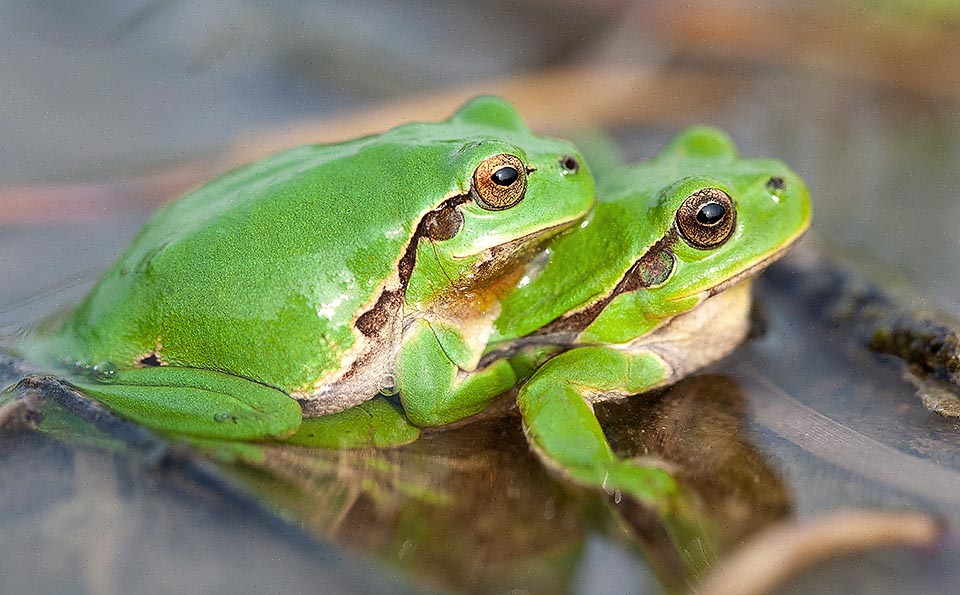
The axillary matings, crepuscular or nocturnal, last some hours to almost 2 days. The eggs, merged in spherical masses, stuck to plants or submerged objects © Frank Deschandol
This capacity is given by the apical discs of the toes that act as stickers but also by the ventral parts that are crushed onto the substrate when resting. This characteristic allows it to climb even on smooth and perfectly vertical walls.
This species is also an excellent jumper. Thanks to its hind legs well developed it is able to make very long jumps between the shrubs and the trees.
The Common tree frog is active mainly during the night, even if it can be observed seldom during the hours of light in the periods of early spring and early autumn.
During the night the males emit their calls to attract the females or for a territorial purpose forming choirs of many dozens of individuals and reach considerable hearing distances.
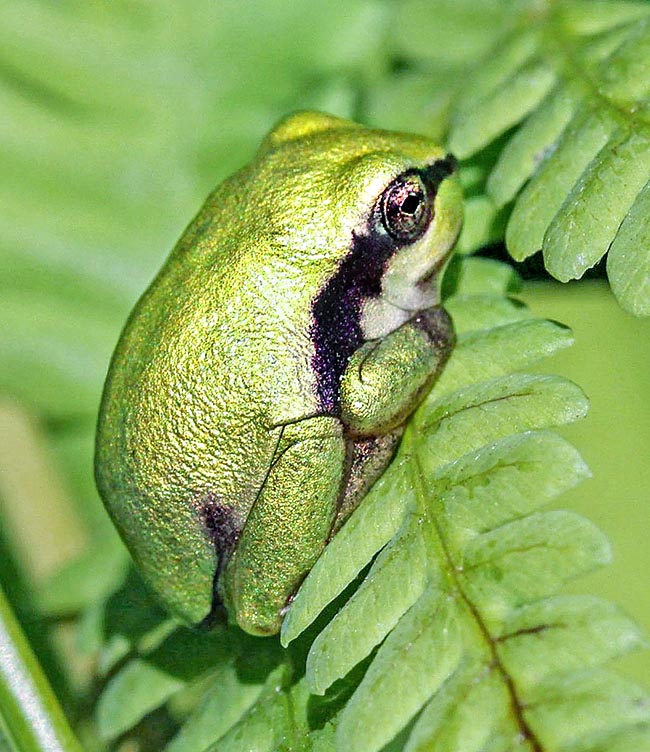
Tadpoles metamorphosis occurs within 3 months. This young has still the residue of the tail © Ge van ‘t Hoff
However, it is possible to hear their calls also during the day if the weather conditions allow it.
The male emits its song only when it is out of the water or when it’s as such only with the head.
The Common tree frog feeds mainly on insects and small terricolous invertebrates and is an active hunter so much that it can seize its preys even while they are flying.
It is hunted by mammals that frequent the humid environments, aquatic birds like night herons and herons, ofids of the genus Natrix and carnivorous fishes.
It may also be prey to raptors when it spends its activities on the trees or shrubs.
The tadpoles are detritivorous of organic matter on the seabed, aquatic plants, algae and plankton. They are preyed upon by fishes and aquatic birds, at times even by other amphibians.
In nature its lifespan is 3-5 years.
The reproductive season begins in February-March in the warmest zones and ends in July in the coolest areas.
There is a trend to reproduce in alternate years.
The males call the females for mating that takes place in an axillary manner.
The matings occur at dusk or during the night and may last from some hours up to almost 2 days.
At the end, the female lays the eggs in single spherical masses that attach to aquatic plants or other objects present in the water.
During the whole season of matings one single female may get to lay 700 to 1000 eggs. The eggs have a diameter of 1,5-2 mm, but the dimensions double if we consider also the gelatinous shell protecting them.
The tadpoles of Common tree frogs come to life after 2-3 weeks, the period varies depending on the environmental conditions.
They appear with an olivaceous upper colour or brown-yellowish with golden lateral specklings.
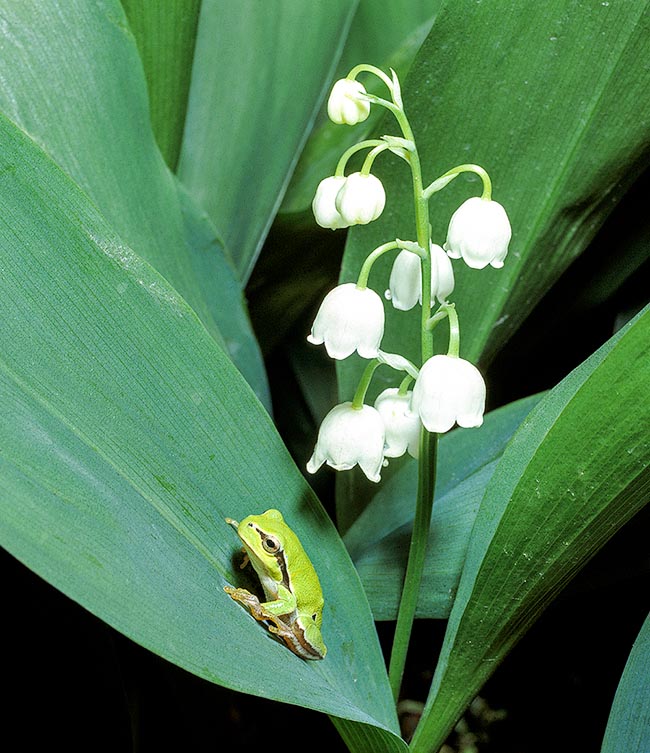
Hyla arborea lives 3 to 5 years. Sexual maturity is reached when 2 years old by males and about 3 by the females © Giuseppe Mazza
Conversely, on the ventral side the colouration is whitish with some specklings of golden or nacre colour.
The tail is yellowish in the muscular area and can present some dark coloured dottings. It often presents a dark stripe placed at half its height.
The body of the Common tree frog is as long as half of the tail.
The eyes are lateral. The tadpole presents with only one spiracle on the left side of the body and is directed up and backwards.
The larvae of the Anura in fact display the gills enclosed in a peribranchial cavity and these communicate with the outside through an opening, the spiracle.
The length of the tail is double or more than the height and its apex is more or less sharp.
The dorsal crest can extend up to the eyes and laterally appears very compressed. The ventral crest is as high as the dorsal and reaches about halfway down the belly.
Upon birth they are about 5 mm long, with their gills with barely ramified gills. They have an active life and are skilled swimmers. Sometimes they approach the water surface to get air and if the body of water is shallow they can stay in the sun. If they are threatened or they are in danger, they escape swimming quickly towards the bottom.
The metamorphosis takes place at most when they are 3 months old, and during this development the tadpoles develop the limbs for their arboreal and jumping life; the gills are absorbed and the lungs for the aerial breathing develop; the tissues of the tail are reabsorbed. By the end of the metamorphosis the juvenile has the same appearance of a 1,5 cm long adult. Sexual maturity is reached by the males before when 2 years old and then by the females one year later.
Synonyms
Rana arborea Linnaeus, 1758; Rana viridis Linnaeus 1761; Hyla viridis Laurenti, 1768; Hyla vulgaris Lacépède, 1788; Calamita arboreus Schneider, 1799; Calamita viridis Schneider, 1799; Hylaria viridis Rafinesque, 1814; Hyla arborea Cuvier, 1816; Hyas arborea Wagler, 1830; Dendrohyas arborea Tschudi, 1838; Dendrohyas arboreus Fitzinger, 1843; Hyla arborea arborea Boulenger, 1882
→ For general notions about Anura please click here.
→ To appreciate the biodiversity within the FROGS please click here.
